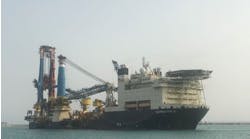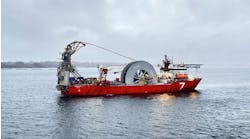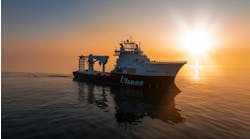Offshore staff
OSLO, Norway — DNV has opened Phase 2 of its H2Pipe joint industry project (JIP) to develop a new code for the design, requalification, construction and operation of offshore pipelines for transporting hydrogen, either in pure form or blended with natural gas.
The classification society anticipates that more than 50% of hydrogen pipelines globally (up to 80% in some regions) will be repurposed from existing natural gas pipelines, as this would cost less than 35% compared with newbuild pipeline systems.
However, a large-scale deployment of hydrogen transport through pipelines requires an optimum balance between safety and cost-effectiveness, DNV said. This means applying more accurate, reliable and possibly less conservative code requirements for newbuild pipeline design; assessing requalification of existing infrastructures; and improved understanding of the actual design limitations.
Operators are examining transportation of hydrogen as an additive or replacement for natural gas, but current offshore pipeline codes do not sufficiently cover the transport of hydrogen or hydrogen blends.
DNV’s standard for submarine pipeline systems (DNV-ST-F101) includes hydrogen as a listed transport product, but further considerations are needed to achieve the target safety level for increased use of hydrogen. One area of concern is hydrogen’s potentially detrimental influence on resistance to cracking in carbon steels.
Hence the need to update the standard to deliver design and material requirements that do not compromise pipeline integrity and safety.
Phase 1 of H2Pipe started in 2021 with an initial test program investigating potential degradation of steel pipe mechanical properties, with various test parameters considered. The first revision of the guideline was delivered to the JIP participants later that year, but specific acceptance criteria are now needed, DNV said.
Phase 2 of H2Pipe, due to start in late March, will run for two years and will feature an experimental test program to determine the governing hydrogen embrittlement mechanisms and how hydrogen affects the integrity of line pipe material.
Other tasks will include a feasibility level design of offshore hydrogen pipelines and a risk assessment study into the safety aspects of offshore hydrogen pipelines. The results should provide guidance for use in design and repurposing of offshore pipelines for hydrogen transport.
“With real design limitations, industry players will be able to design—or repurpose—pipeline systems fit for the safe transportation of hydrogen, and to implement adequate mitigation measures if necessary,” said Jan Fredrik Helgaker, DNV's senior engineer and JIP lead of energy systems.
02.20.2023



